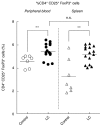Modulation of CD4⁺ T cell responses following splenectomy in hepatitis C virus-related liver cirrhosis
- PMID: 21615390
- PMCID: PMC3142649
- DOI: 10.1111/j.1365-2249.2011.04393.x
Modulation of CD4⁺ T cell responses following splenectomy in hepatitis C virus-related liver cirrhosis
Abstract
Dysfunction of T cells is a common feature in chronic persistent viral infections, including hepatitis C virus (HCV), and although hepatic and peripheral T cells have been studied extensively in chronic HCV hepatitis, the role of splenic T cell responses in such patients is poorly defined. This is an important issue, as thrombocytopenia is a complication of HCV-related liver cirrhosis (LC), due to splenic platelet sequestration and bone marrow suppression; splenectomy has been proposed to treat such patients. Herein, we studied peripheral blood mononuclear cells (PBMC) and splenic lymphoid subpopulations from a total of 22 patients, including 15 with HCV-related LC with marked thrombocytopenia treated with splenectomy, and seven controls. CD4(+) T cells from peripheral blood and spleen were isolated and phenotype and function evaluated. Splenic CD4(+) T cells in patients with LC expressed molecules associated with inhibitory signalling, including increased frequency of negative markers such as cytotoxic T lymphocyte associated antigen-4 (CTLA-4) and programmed death 1 (PD-1) and decreased production of cytokines. Patients with LC manifest higher levels of splenic CD4(+) regulatory T cells and PD-L1- and PD-L2-expressing cells than controls. Blocking of PD-1/PD-1 ligand interaction reconstituted proliferative and cytokine responses of splenic mononuclear cells (SMC) from patients with LC. Splenectomy was followed by an increase in the ratio of interferon (IFN)-γ to interleukin (IL)-10 and a reduction of PD-1-expressing CD4(+) T cells in peripheral blood. Our data suggest that peripheral tolerance is promoted by the spleen in LC via the up-regulated expression of PD-1 ligands.
© 2011 The Authors; Clinical and Experimental Immunology © 2011 British Society for Immunology.
Figures







References
-
- Lauer GM, Walker BD. Hepatitis C virus infection. N Engl J Med. 2001;345:41–52. - PubMed
-
- Shepard CW, Finelli L, Alter MJ. Global epidemiology of hepatitis C virus infection. Lancet Infect Dis. 2005;5:558–67. - PubMed
-
- Manigold T, Racanelli V. T-cell regulation by CD4 regulatory T cells during hepatitis B and C virus infections: facts and controversies. Lancet Infect Dis. 2007;7:804–13. - PubMed
-
- Urbani S, Amadei B, Fisicaro P, et al. Outcome of acute hepatitis C is related to virus-specific CD4 function and maturation of antiviral memory CD8 responses. Hepatology. 2006;44:126–39. - PubMed
MeSH terms
Substances
LinkOut - more resources
Full Text Sources
Medical
Research Materials

